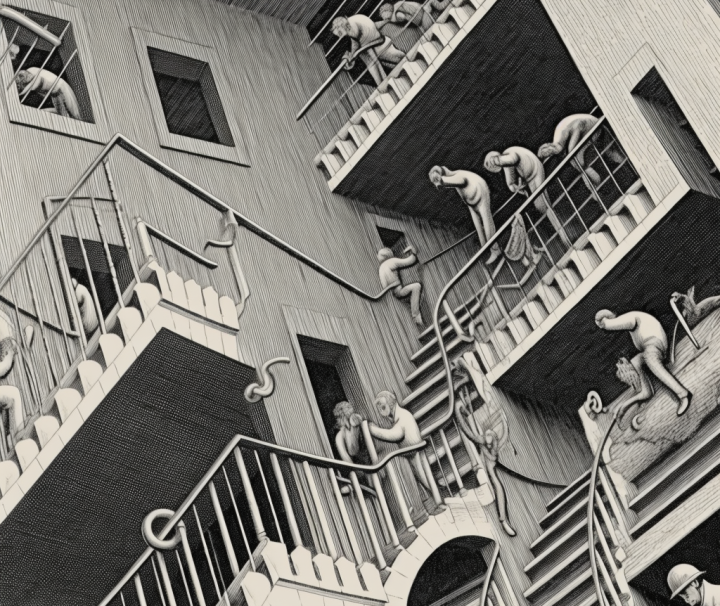LIVE SMARTER
The impact of emigration on familial bonds

Each family member may experience the impact of emigration in a different way. Family members back home may worry about growing apart over time, and the emigrants may worry about being excluded from the family by missing family gatherings. This sense of being out of sync with your loved ones causes experiences to be perceived as relative and puzzling.
As a family therapist specialising in emigration, I am constantly reminded of the endless possibilities and impossibilities caused by emigration in the 21st century. In particular, families are confronted by a new reality that involves living across different continents where digital forms of communication are the primary means of connecting them to one another.
At first glance, emigration seems relatively simple. Upon closer examination, however, it becomes apparent that emigration is much more complex. Similarly, at first glance Relativity, a lithographic print by MC Escher, the artist who created the most memorable images of the 20th century, may seem somewhat uncomplicated, but upon further examination, the viewer experiences the same sense of disillusionment. This article uses the isomorphism between the art of MC Escher and emigration to explore the depth and complexity of the latter as a contemporary phenomenon.
The disturbing reality of Relativity
In the artwork Relativity, which dates to 1953, the Dutch artist depicts a world in which the normal laws of gravity do not apply. It was inspired by the instability of life in Europe after World War 2, with many people being uprooted from their homeland. The artwork portrays this experience as confusing and mesmerising.
Escher sketches a detailed architectural scene of various staircases that are intertwined in such a way that the setting in its entirety seems to make sense. Yet, the different stairways originate and terminate on different horizontal and vertical planes. At first glance, the composition seems in order, but on closer inspection it proves fictitious, leaving the onlooker puzzled and slightly amused. The confusion is reinforced by people walking up and down the stairways, intersecting at levels that are impossible in real life. The detailed manner in which Escher crafts the scene fools the brain into believing that the construction is indeed possible, but the laws of gravity turn the composition into fantasy.
Read more from our series of Live Smarter articles
In 1953, Escher described the discomforting artwork as follows: “Here we have three forces of gravity working perpendicularly to one another. Three earth-planes cut across each other at right angles, and human beings are living on each of them. It is possible for the inhabitants of different worlds to walk or sit or stand on the same floor, because they have differing conceptions of what is horizontal and what is vertical.”
Escher thus describes an unusual reality in which an endless procession of faceless figures inhabits a mechanically driven world. This unreal architectural construction evokes a disquieting feeling in the viewer that symbolises the emotional experience of immigrants and their loved ones left behind. They experience their world as “disconnected”, a visual representation of the transnational family.
Escher’s artwork conveys an “inner vision” where reality is expressed as an impossible architectural construction and its inhabitants live side-by-side – seemingly moving in the same direction – yet, unaware of the other’s existence. In Escher’s world, where the inhabitants have different conceptions of reality, reality is experienced as a relative rather than an absolute.
Escher’s combination of detailed realism and fantasy creates an unworldly feeling that is well-known to the disconnected families who are affected by emigration.
Still a family?
Emigration creates an ambiguous reality that challenges the conventional definition of a family.
In its simplest form, a family consists of two parents with one or more children sharing the same space. When an adult child emigrates, he or she becomes a global citizen. The ambiguity lies in the fact that, as members of a family, they share a common history with those in the home country but also face an unknown future.
This confusing new reality is captured in Escher’s impossible architectural construction. Just as the figures in the lithograph continue to move past each other on infinite sets of stairs without being aware of each other, transnational families are geographically separated. While the longing to reach out to loved ones remains, the reality is that they exist in different dimensions with a pervasive sense of isolation.
The experience of different cultures and worldviews unsettles one’s understanding of the other’s circumstances and makes it even more challenging for transnational families to fully understand each other. Although they desire to be part of each other’s worlds, the reality is that they exist in different dimensions, in worlds with divergent experiences.
Each family member’s experience of their new reality is unique. Due to a lack of understanding of the contexts of these different lifestyles, family members may struggle despairingly to engage in spontaneous communication. On the one hand, family members back home may wonder: will we grow apart over time, and will they eventually forget about us back home? On the other hand, the emigrants themselves may feel like they are being excluded from the family by missing family gatherings. This sense of being out of sync with your loved ones causes experiences to be perceived as relative and puzzling.
Our worlds will always be connected
Despite the confusing environment, the figures in the artwork continue to move forward, navigating the “stairs” and finding their way meaningfully. This resilience reflects the determination of transnational families to creatively confront the emotional challenges of emigration.
The relationship between the emigrant and those left behind in the country of origin goes much deeper than mere superficial and physical connections. The shared history of experiences and common moments create a familiar space where transnational families’ relationships can endure and deepen across time zones.
“In my prints, I try to show that we live in a beautiful and orderly world and not in chaos without norms, as we sometimes seem to,” writes Escher. Art as a visual metaphor makes it possible to make sense of the ambiguous reality caused by emigration and to explore, interpret and try to understand its complexities.
After all, art knows no boundaries. DM
The author would like to thank Cilliers Willers for being an integral part of this emigration research journey.



















 Become an Insider
Become an Insider
It was probably same in the 70s when South Africans went into exile as now with youngsters seeking a future where their government is not an ongoing slow motion train wreck. When you get past (1) anger that our kids have to go (2) sadness at the physical distance : you find the positives. Being glad they have a better future. Being proud of their bravery.
Basically, us parents get over their emigration when we stop making it about us…
Exactly.
Although I will probably never leave, I have never regretted getting my children out of South Africa. Fortunately we saw the signs over 20 years ago.
This article spoke volumes to me, as someone who isn’t in RSA anymore. Technology helps close the gap for information, but unfortunately only proximity builds relationship.